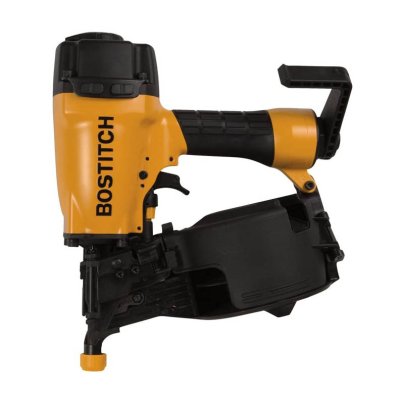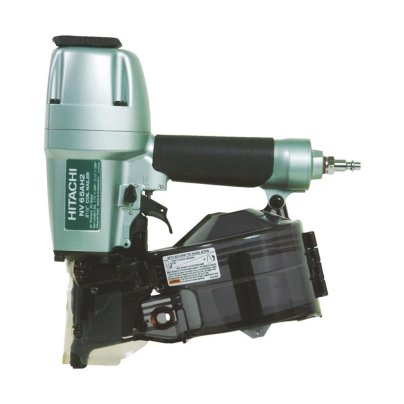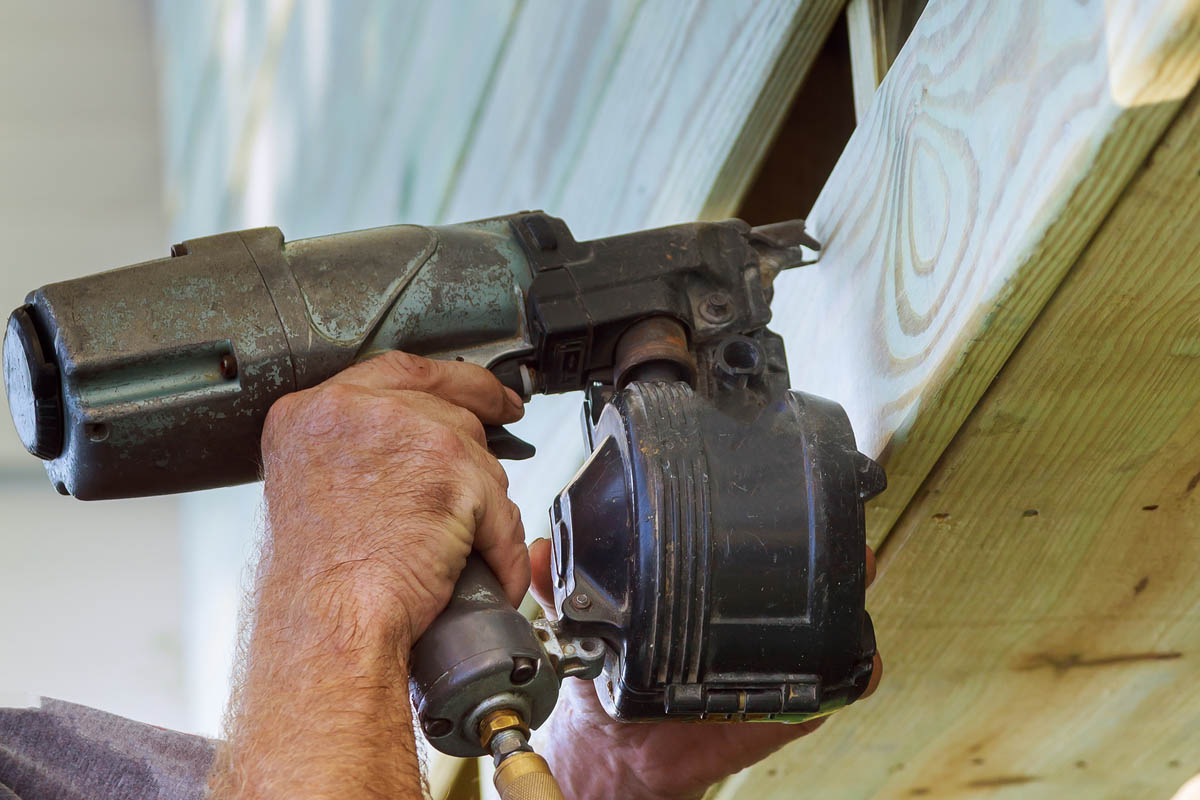
We may earn revenue from the products available on this page and participate in affiliate programs. Learn More ›
Siding helps protect the structure of your home, adds an extra layer of insulation that can lower your energy bill, and adds curb appeal to enhance the value. You can use an ordinary hammer when installing or repairing siding, but a siding nailer is undeniably quicker. It inserts each nail to the same depth with a single blow so the siding is properly secured.
At first glance, the specifications and capabilities of siding nailers can be confusing. This guide will clarify the differences between types of nailers and help you find the best siding nailer for your projects.
- BEST OVERALL: Bostitch 1¼-to-2½-Inch Coil Siding Nailer
- BEST BANG FOR THE BUCK: Freeman Pneumatic 2½-Inch Coil Siding Nailer
- UPGRADE PICK: Hitachi Metabo 2½-Inch Coil Siding Nailer
- BEST KIT: Metabo HPT The Tank 6-Gallon Pancake Air Compressor
- ALSO CONSIDER: HBT HBCN65P 15-Degree Coil Siding Nailer
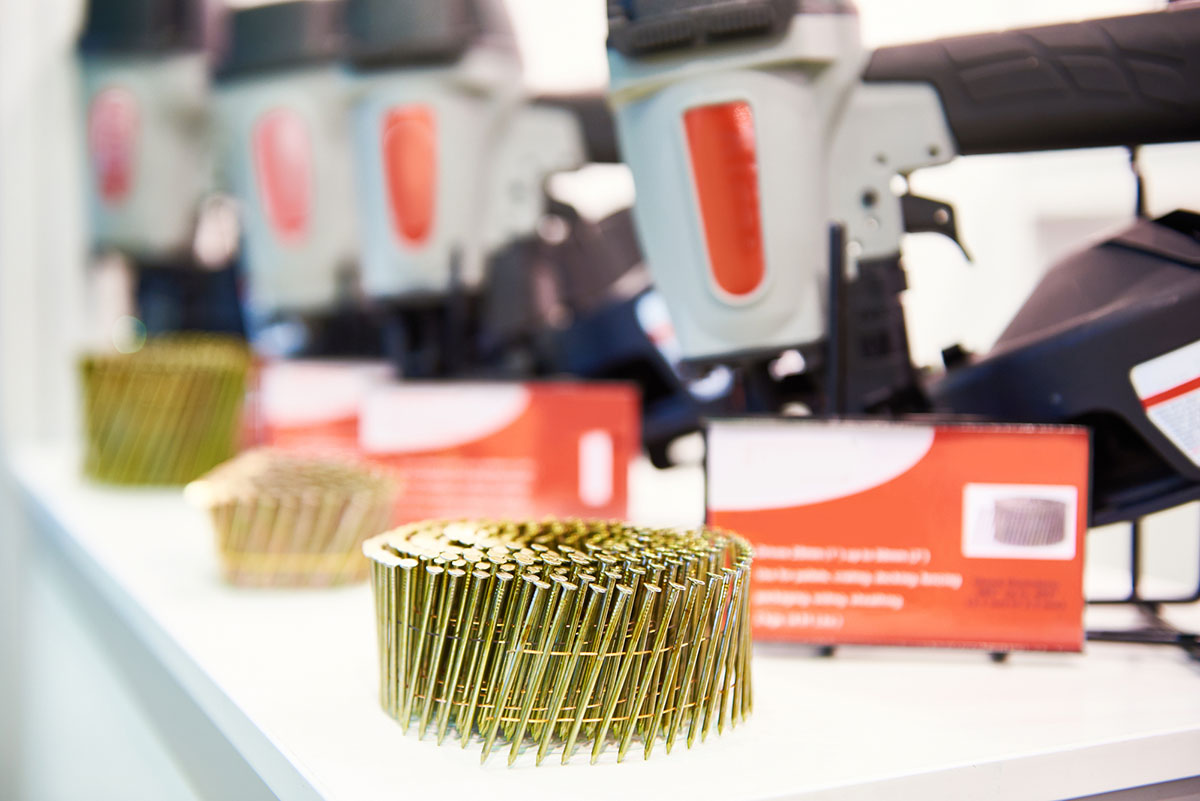
Before You Buy a Siding Nailer
There are a wide variety of nailers (or nail guns) available to fulfill different tasks. They range from compact brad nailers for detailed work to heavy-duty framing nailers, some of which are capable of driving nails over 6 inches long.
A siding nailer is a very function-specific tool. The best siding nailer will help you complete the task quickly, but first think about the project for which you are using it. If you have a lot of siding to fit, a siding nailer is what you need, but if you only have modest repair work to do—and you’re torn between a siding nailer and a framing nailer—then a midsize version of the latter should be capable of doing the job.
How We Chose the Best Siding Nailers
I am an engineer by trade, and I have completed ground-up renovations of two homes, so I have experience with a variety of nail guns. To supplement my own knowledge, we did in-depth market research to make sure we knew the range that was currently available.
Durability and reliability are key issues. It’s important to know that the tool will hammer in nails all day, with as little fuss as possible, and then do it all again tomorrow. All nailers jam sometimes (often because of small flaws in the nails), so tool-free release makes life a lot easier, especially if you’re up a ladder. Weight and balance are also important factors. A heavy siding nailer can soon become tiring.
Finally, there’s value for money. Mostly we stuck with brands that have a proven reputation, but we did find a couple of budget-friendly models that are worth considering.
Our Top Picks
The following list was collated with a combination of personal experience and market research. It factors in manufacturer reputation, durability, features, and cost. The best siding nailer in each category has been chosen to help you focus on the right tool for your specific needs.
Best Overall
Bostitch 1¼-to-2½-Inch Coil Siding Nailer
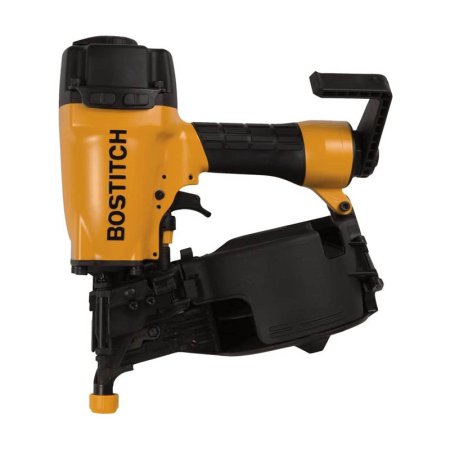
Pros
Cons
Product Specs
- Nail length: 1¼ to 2½ inches
- Magazine capacity: 300
- Weight: 4.7 pounds
This Bostitch coil siding nailer delivers all the features you need in a well-balanced tool that weighs just 4.7 pounds. It takes either wire weld or plastic insert nails from 1¼ to 2½ inches in length. Its magazine capacity is 300. Operating range is 70 to 120 pounds per square inch (psi) with tool-free depth setting, a no-mar foot, and an easy-to-adjust exhaust.
The Bostitch is supplied with contact firing enabled—the professional’s preference—though it can be converted to sequential firing by changing the trigger.
Get the Bostitch siding nailer at Amazon, Acme Tools, or Walmart.
Best Bang for the Buck
Freeman Pneumatic 2½-Inch Coil Siding Nailer
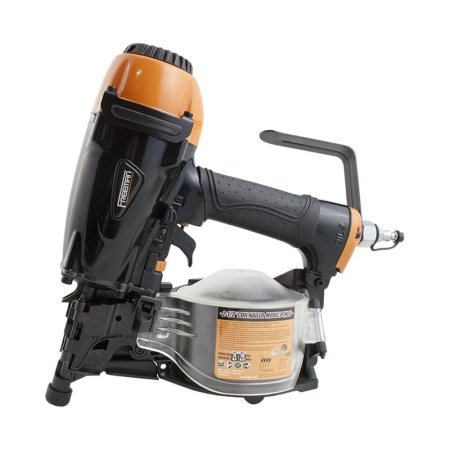
Pros
Cons
Product Specs
- Nail length: 1¼ to 2½ inches
- Magazine capacity: 400
- Weight: 5.5 pounds
Freeman tools are recognized for their combination of durability and value. Despite the low cost of the Freeman siding nailer, it offers a feature set that rivals those of more expensive competitors.
The use of magnesium keeps the weight down to a manageable 5.5 pounds. The 400-nail magazine accepts common sizes of both plastic and wire collated nails, which are fired at adjustable depths via a no-mar tip. Operating pressure is 70 to 110 psi and exhaust can be rotated 360 degrees. Freeman also includes a pair of safety goggles.
This nailer is a little more prone to jams than some models and might misfire occasionally. These are unlikely to be problems that unduly trouble a DIY user. However, it does not offer sequential firing.
Get the Freeman siding nailer at Amazon, Lowe’s, or The Home Depot.
Upgrade Pick
Hitachi Metabo 2½-Inch Coil Siding Nailer
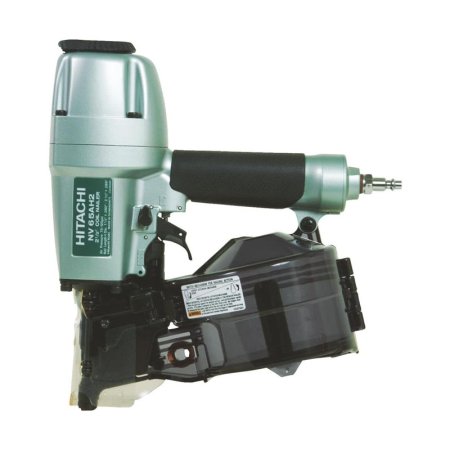
Pros
Cons
Product Specs
- Nail length: 1½ to 2½ inches
- Magazine capacity: 300
- Weight: 4.8 pounds
At just 4.8 pounds, the Hitachi Metabo is among the lightest in its class. It’s physically compact, too, making it easy to work with. The tool will handle the usual range of siding nails, both wire and plastic, from 1½ to 2½ inches in a quick-loading magazine. It can fire them at up to three nails per second.
The Hitachi Metabo offers both sequential and contact firing, changed at the flick of a switch. Depth adjustment is by simple dial and exhaust direction is tool-free. There’s also a shield to deflect wire debris away from the user and a no-mar tip. Operating pressure is 70 to 120 psi.
This comprehensive range of user-friendly features comes at a premium price, but for the demanding professional, the investment will likely be worth it.
Get the Hitachi siding nailer at Lowe’s or Acme Tools.
Best Kit
Metabo HPT The Tank 6-Gallon Pancake Air Compressor
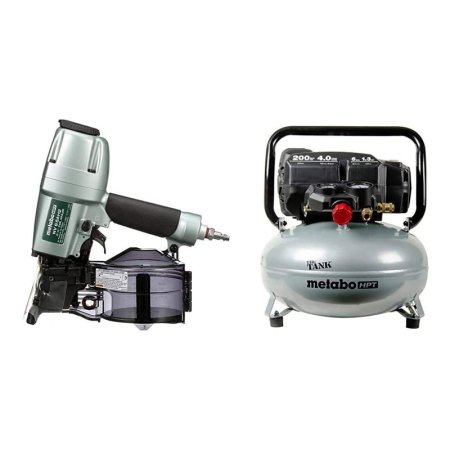
Pros
Cons
Product Specs
- Nail length: 1½ to 2½ inches
- Magazine capacity: 300
- Weight: 4.8 pounds (gun), 41 pounds (compressor)
All pneumatic siding nailers require an air compressor to function, but finding the right model at an affordable price is not always straightforward. Metabo solved the problem by offering a siding nailer and matching compressor as a pair. It’s a convenient option—and both are high-quality items—but for the contractor, the kit offers more than might be obvious at first glance.
The Metabo siding nailer is a fully featured model that takes all standard siding nail types and sizes and offers sequential or contact firing. It operates at up to 120 psi and features tool-free adjustment of depth and exhaust. It’s a very good tool, but it’s the compressor that stands out. With its 200 psi capability, it could power two siding nailers at the same time, or alternatively, two different types of nailer. For partners or small teams, that provides tremendous versatility.
Get the Metabo HPT siding nailer at Amazon.
Also Consider
HBT HBCN65P 15-Degree Coil Siding Nailer
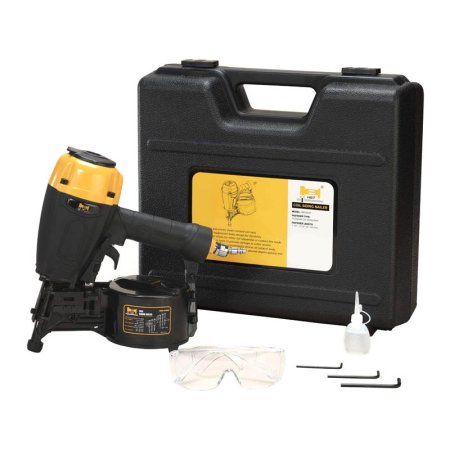
Pros
Cons
Product Specs
- Nail length: 1½ to 2½ inches
- Magazine capacity: Not specified
- Weight: 6.4 pounds
Many coil siding nailers look similar, so it’s not until examining the specifications that you find what separates professional-standard tools from their budget counterparts. However, with the extensive features offered by the HBT siding nailer, those differences are not easy to see.
At 6.4 pounds, this siding nailer is among the lighter models, though it offers up to 120 psi of operating pressure. The magazine accepts both plastic and wire collated nails from 1¼ to 2½ inches and is transparent, so you can see when nails are running low. Depth adjustment is tool-free, as is the rapid jam-release mechanism. It has a no-mar tip and a 360-degree swivel for the exhaust. A simple switch changes it from sequential to contact firing.
All of this comes in at significantly lower cost than similarly specified competitors. It might not have the long-term durability of some, but few DIY users will find that to be a problem.
Get the HBT siding nailer at Amazon.
Jump to Our Top Picks
What to Consider When Choosing a Siding Nailer
There are many different siding nailers to choose from. Some are more suited to low-volume DIY use, while others are heavy-duty professional models. When deciding which will be the best siding nailer for the jobs you need to undertake, look for one that is high-quality and offers the right combination of features.
Size and Weight
Balance and weight are key features of siding nailers. If a tool is top-heavy, it will stress your wrist, which will quickly become uncomfortable. Much of the time, fitting siding necessitates being up a ladder where a bulky tool could be difficult to control. Siding nailers aren’t particularly heavy—4½ to 6½ pounds (framing nailers can be twice that)—but a single pound can make a big difference when you’re using the tool for extended periods.
To combat both of these problems, aluminum and magnesium alloys are frequently used for things like motor housings instead of steel. This reduces weight at the top of the nailer where it most affects handling but doesn’t reduce durability or performance. It’s also worth checking the hand grip. A textured, rubberized handle allows for a firm, confident hold.
Nail Type and Length
The frame of the house and the siding often move slightly as seasons change, so siding nails have a round head to prevent the siding from pulling free. The shank of the nail is usually textured, either with rings or a spiral, to improve grip on the wood.
The most common material is galvanized steel. Electroplated is the more economical type, though hot-dipped galvanizing provides a thicker, more durable coating. Wood for shingles or clapboard sidings that contain natural tannins will attack ordinary steel, so aluminum nails may be used instead. Stainless steel is another option—particularly in coastal areas—because it’s more resistant to the salt in the air.
Length varies from 1½ to 2½ inches, with longer nails generally being employed when a liner, backing board, or battens are positioned between frame and siding.
Magazine Capacity
Siding nails are provided in a long coil, almost always set at a 15-degree feed angle, and are collated (held together) either by welded wire or plastic ribbon. The former is less expensive, whereas the latter provides a neater finish. This coil fits into the magazine on the nailer and feeds automatically. Some siding nailers can use either collation type, but it’s not always the case.
Magazine capacity varies from 300 to 500 nails depending on model and nail size. It’s tempting to think that the best framing nailer has the largest capacity. It will certainly mean the gun can be operated for longer before needing to be reloaded, but 500 nails of any size weigh significantly more than 300. That could tire the user more quickly. Most magazines are side loading, which is fast and easy.
Operating Pressure
Some types of nailers offer a choice of power source. They may be battery, corded, or pneumatic powered. That’s not true of siding nailers, which currently are all pneumatic. This means you need an air compressor to run them. There are many different models available, and lightweight portable compressors have their advantages, but it’s important that the one you choose can supply adequate operating pressure. Generally speaking, that will be somewhere between 70 psi and 120 psi.
It’s also important to have a sufficient high-pressure hose to reach from the compressor sitting on the ground to the highest point where the siding will be fitted. This usually has to be purchased separately, so it’s vital the specification and type of fitting are checked before ordering.
Firing Mode
A siding nailer can fire the nail in one of two ways: either sequential or contact (also called “bump”). Anyone who has used a nail gun of any type will have come across sequential firing, which simply means the nail is fired when the trigger is pressed.
Contact firing works with the trigger continually depressed. The mechanism is then activated as soon as the nose of the nailer is bumped against the siding material. In the hands of an experienced contractor, the technique can look very impressive, with nails being fired several times a second. However, skill is required for consistent nail positioning, and it takes time to learn. DIY users will find sequential firing much more controllable. Some siding nailers are switchable between modes.
Depth Adjustment
Having depth adjustment is important for two reasons. First, it compensates for using nails of different lengths. Second, it can alter the firing pressure to suit the wide variety of siding materials available.
Normally when you insert a nail, whether with a hammer or a nail gun, you want that nail head to be driven flush with the surface, or even slightly below. When you’re fitting siding, you need to leave a small gap to allow for the natural movement we mentioned earlier. Wood, vinyl, concrete, etc., all have different amounts of resistance as the nail passes through. If the depth were fixed, it would be impossible to use the same gun for different materials. The best siding nailer can be adjusted to compensate.
Jam Removal
All nailers jam occasionally. With budget models, it may be that the mechanism isn’t as well made as it might be, though faults in the nail coil or small bits of debris getting caught inside the nailer can also cause problems.
Whatever the reason, a jammed nail is frustrating at best. Being able to remove it quickly is a valuable feature. As most jams occur in or near the nose of the nailer, easy access to this area should be provided. Being able to clear a jam without needing your tool kit is a definite advantage, and good siding nailers make this possible.
Whatever method is offered, always remember to disconnect the air hose before attempting to remove a jammed nail. An accidental misfire could be extremely dangerous.
Additional Features
While the sections above cover the key elements when choosing the best siding nailer, there are several other features that add convenience.
In order to expel air after each strike, siding nailers have an exhaust. If it’s poorly directed, it puffs air straight in your face. It’s not dangerous, but it’s nice if it can be directed elsewhere.
A no-mar rubber nose (which oddly is called a “foot” on some models) helps stop the nailer from marking the surface of the siding. If you’re using wire collated nails, the gun will eject small pieces of wire debris as you work, so the facility to catch or direct these is also useful. A lock setting, which prevents accidental firing, is an added bonus, increasing safety. Several models also incorporate a useful belt hook.
Tips for Using a Siding Nailer
Siding nailers are powerful tools, but they can be dangerous, so safety is an extremely important consideration. Here are some tips that will help you stay safe and do a top-notch job.
- Always wear safety glasses, ear protection, and sturdy footwear. Gloves are also recommended. Never work when you are not 100 percent fit and focused.
- Never point a siding nailer at anyone. Ensure the work area is free of people and pets. Check for trip hazards.
- If the siding nailer jams, disconnect the air supply before attempting to free it. If a nail doesn’t fire, don’t assume the nailer is empty.
- Double-check your depth setting before you start. Ensure your compressor is providing sufficient air pressure.
- Contact firing is much faster than sequential (trigger activated), but it requires concentration and good control of the tool. If you’ve never used the feature before, practice on a few pieces of scrap wood until you’re comfortable with it.
- If using sequential firing, place the gun firmly against the siding before squeezing the trigger.
- Hold the nailer vertically so that the nail enters the siding at 90 degrees, not sloping up or down. Supporting the rear of the nailer with your free hand may help.
FAQs
The information above will undoubtedly leave you better informed about which would be the best siding nailer for your project. However, it’s understandable that questions may remain. The following answers address some of the most common concerns.
Q. Can you use a siding nailer for framing?
It’s not recommended. The maximum nail length in a siding nailer is 2½ inches, and framing usually requires a more powerful hold. Framing nailers normally use nails that are 3½ inches in length, or longer. In most cases, the name of the tool tells you what task it best suits. Hence, you have pin nailers for light-duty trim; palm nailers for tight spots; and others specifically called siding, framing, and roofing nailers to identify their function.
Q. Can you use a siding nailer for roofing?
It might be possible though it depends on the tool, and each will need to be looked at individually. The big difference is the type of nail used. Siding nails don’t have the grip necessary for roofing. Roofing nails typically have a larger head than siding nails, and so the siding nailer might not be capable of taking the appropriate diameter.
Air pressure might also be a factor—whether there is sufficient pounds per square inch to drive the roofing nail properly. As with the previous question, it’s always better to use the appropriate nail gun for the job rather than trying to make do.
Q. What size nails do you use for siding?
The most common size is from 1½ to 2½ inches long, with a diameter of either 0.080 inch or 0.092 inch and a minimum crown (head) of ⅜ inch. Shank diameter may also be given as a gauge. Between 11 and 14 gauge is common. The type of siding material and the size of sheathing will have an impact. It’s important that the nail is long enough to provide proper grip. Although it’s time-consuming, it’s a good idea to check the requirements of each job carefully before ordering nails.
Q. Can I use screws for wood siding?
It is physically possible to use screws for siding, and it could be argued that screws have more holding power than nails. However, the process will be much slower. Even use of an automatic screw gun can’t match the speed of a good siding nailer. There’s also the cost of the screws to consider. They are considerably more expensive than nails, so over a large job, the difference could be substantial.
Q. What kind of nails do you use for wood siding?
The usual recommendation is hot-dipped galvanized nails with round heads. The galvanizing process prevents rust. The round head prevents the nails from pulling through the shingle as the wood flexes with changes in temperature and humidity. They should be ring shank or twist shank to improve grip through sheathing and stud.
Stainless steel nails are often suggested for cedar siding, though they are more expensive. Aluminum nails are an alternative for aluminum or vinyl siding.
